Various options for decorating the ceiling in the kitchen with your own hands
Today, on the shelves of construction stores, the assortment contains various materials that can be used not only for decorating walls, but also for ceiling structures. During the repair process, special attention should be paid to the ceiling decoration in the kitchen. There are plenty of options, it all depends on the owner’s budget and his desires. Before making a choice, you should study each of them in detail.
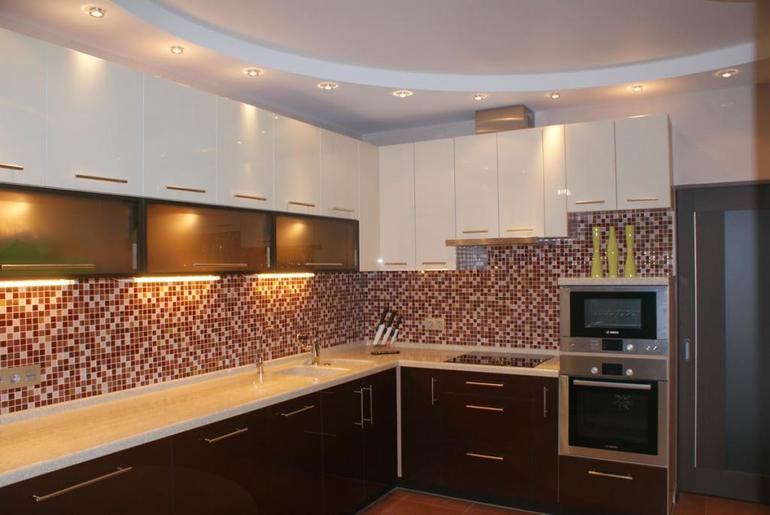
Main aspects
When carrying out repair work in the kitchen, the design of a beautiful and high-quality ceiling structure plays an important role. In order for this interior detail to please the household eye for a long time and not to wear out, you should carefully study the criteria that the ceiling must meet. Some of them:
- environmental friendliness and safety;
- attractive appearance;
- resistance to high temperatures, possible pollution, excessive humidity;
- the ability of a material to conceal defects in floors and communications details;
- combination with interior elements;
- affordable installation;
- acceptable price.
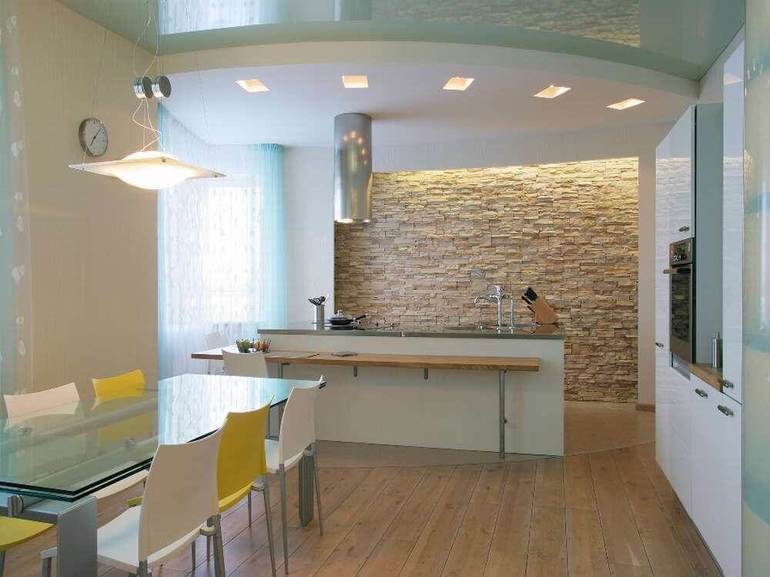
An important factor in choosing a particular type of ceiling decoration in the kitchen is the taste preferences of the owner, because everyone wants to make something fashionable and beautiful. However, it is often not always possible to realize an idea.
So, suspended and multi-level constructions popular today are inappropriate to use in apartments with low ceilings. This is due to the fact that they will take away a lot of space from the room. In addition, the use of wallpaper or paints and varnishes in the presence of even small irregularities on the surface is unacceptable.
Fundamental aspects when choosing a ceiling are the cost of installation and materials. Given these factors, it is necessary to determine the budget for future repairs in advance.
Ways of registration
Today, there is a huge variety of design options for the ceiling in the kitchen. Finishing can be done in various ways:
- whitewash;
- the use of rack structures;
- installation of tiles;
- tension structures;
- painting;
- Wallpapering;
- decorative plaster;
- installation of drywall.
To choose the most suitable way of registration, you should carefully study each of them, taking into account the advantages and disadvantages, as well as the amount of planned costs.
Whitewashing and painting
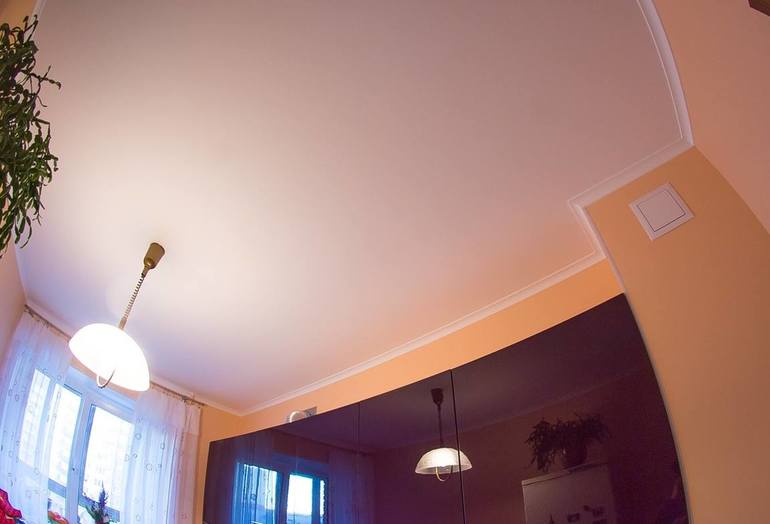
Paradoxically, the use of whitewash is still relevant today. Most likely, this is due to the low cost of the material. Most often, lime is used as a base.
It is important to understand that whitewashing is not the best option for a kitchen due to its low performance. The fact is that temperature fluctuations and high humidity adversely affect the quality of the coating.
Even if you do not take into account “unfavorable” factors, the layer will please the eye for no more than 2 years, and then the whitening will begin to exfoliate. It will not work to clear the ceiling of deposits of grease and soot; you will need to re-carry out the work.
However, this is far from the most important. Before covering the ceiling with whitewash, you should carefully prepare the surface. First of all, this is necessary to improve the adhesion of the composition to the base.
In addition, without preparatory work, all defects in the ceiling will only be emphasized. That is why the following manipulations should first be carried out:
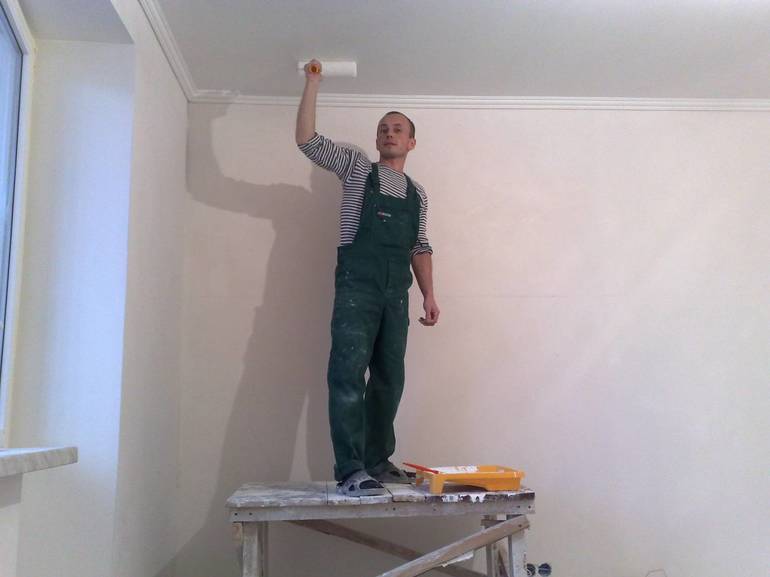
- surface cleaning from previous coatings;
- sealing cracks and indentations;
- leveling the surface with starting and then finishing putty;
- sandpaper processing;
- dust removal;
- primer treatment.
In recent decades, painting has become a good alternative to whitewashing. This method, of course, has several specific advantages. However, before applying paintwork materials, it is also necessary to level the ceiling.
Most often, when choosing this method of decoration, water-based paint is used. As you know, this is an environmentally friendly material, which is characterized by the speed of drying and allows you to give the ceiling structure various shades. Removing contaminants from such a coating is quite simple - just use a soap solution.
Ceiling tile
An ideal and practical option for repairs in an economy class kitchen is the use of polystyrene tiles. In addition, the material has other advantages:
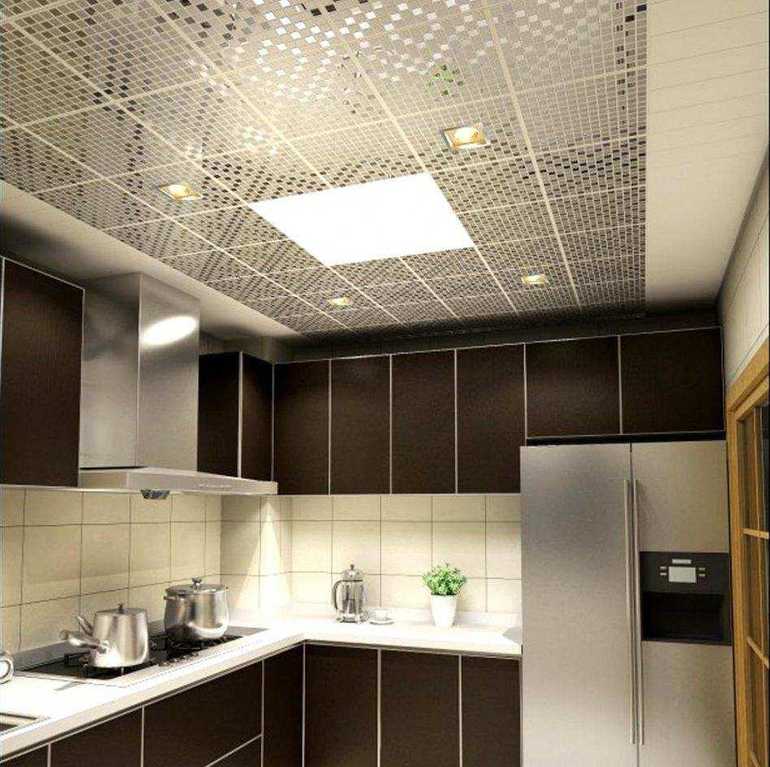
- Resistance to water, which is important for the kitchen.
- A variety of color shades and textures, allowing you to choose the right option and make the interior a special chic.
- Ease of installation. It’s quite possible to trim the ceiling with your own hands, without the involvement of qualified specialists. In addition, the work will not take much time.
- No need to close small cracks. The material will hide all flaws in the ceiling structure due to its flexibility and volume.
- Ease of dismantling. If you are tired of drawing or want to refresh the interior, you can easily remove the tile and stick a new one.
- Another important plus is that the tile can be washed. The only caveat: it is forbidden to use abrasives, because they destroy the structure of the material.
The lack of material is irrelevance among modern design solutions. Simply put, applying tiles today is unfashionable.
Using wallpaper
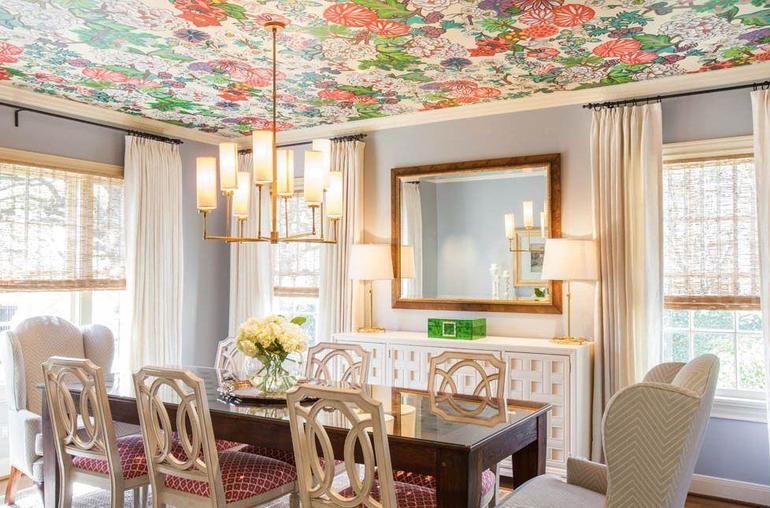
If it is decided to use wallpaper as a finishing material for the ceiling in the kitchen, it is highly desirable that they be moisture resistant and washable. Such materials are often used to decorate walls, but the ceiling has certain features. The fact is that soot and heated air accumulate at the top.
Over time, the wallpaper will begin to become dirty and lag behind the ceiling. The best option is to use vinyl products on which stains can be painted or cleaned with a wet rag.
Before gluing the ceiling, its surface must be cleaned. In addition, it is permissible to use liquid putty. Experts recommend a primer treatment to improve the adhesion of the adhesive to the base.
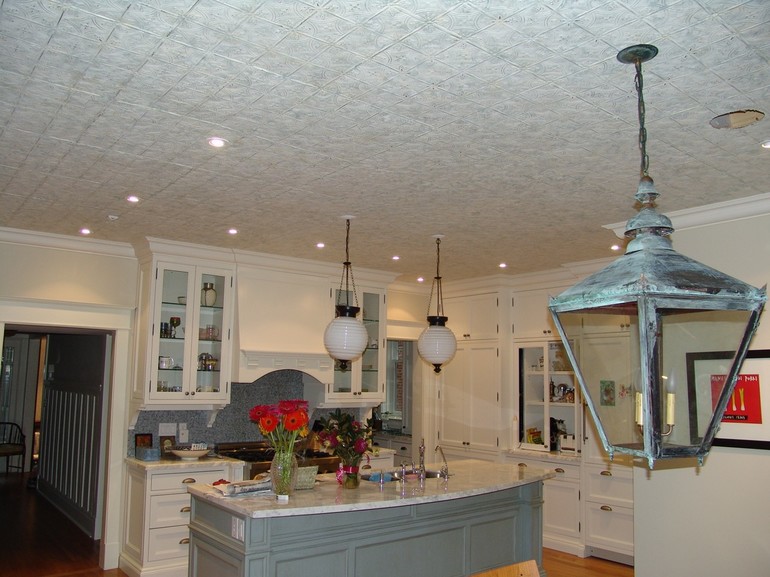
A great alternative to paper coating is liquid wallpaper. They are resistant to temperature and moisture, do not lag behind the surface. In the event of defects, they can be easily removed by applying a new layer. Various color schemes are on sale. The dry composition should be diluted with water and applied to a pre-primed surface. The disadvantage of this finish is the high price of raw materials.
Decorative plaster
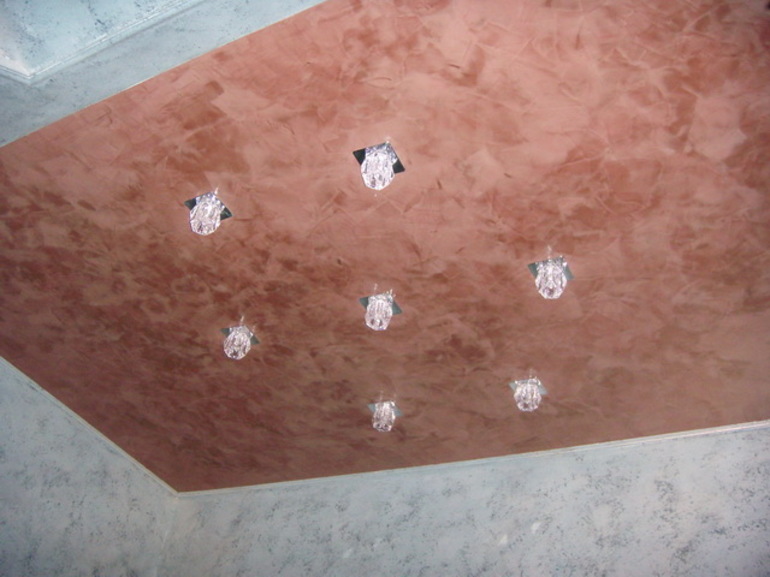
As you know, this material is often used to decorate walls, but practice shows that it can be used to successfully finish a kitchen ceiling. The coating is durable and easy to care for.
The surface must first be leveled and obvious defects removed. There is no need to get rid of small cracks - the material itself will mask them. As with wall decoration, all types of decorative plaster can be used for ceiling construction.
The previously listed methods of designing a kitchen ceiling have one thing in common - the height of the room is preserved. It sometimes happens that the differences in the ceiling structure exceed 5 cm. In this case, you should resort to other finishing methods, for example, hanging or tensioning options.The latter can be used if the height of the walls is not less than 2.7 m.
Drywall
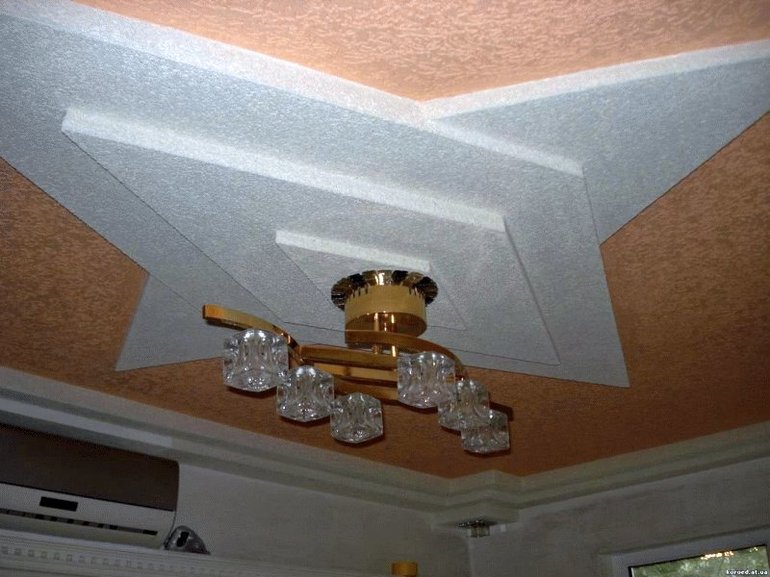
One of the types of suspended ceiling systems are drywall constructions. The material is available in the form of sheets that are installed on a pre-prepared metal frame.
Such a system makes it possible to mask not only defects in the ceiling, but also all kinds of utilities, including ventilation or electrical wiring. Of course, it is best to use a moisture resistant material for the kitchen. Minor defects after sheet installation (butt joints, screw holes, scratches) can easily be repaired with putty. Drywall can be pasted with wallpaper, decorative plaster or painted.
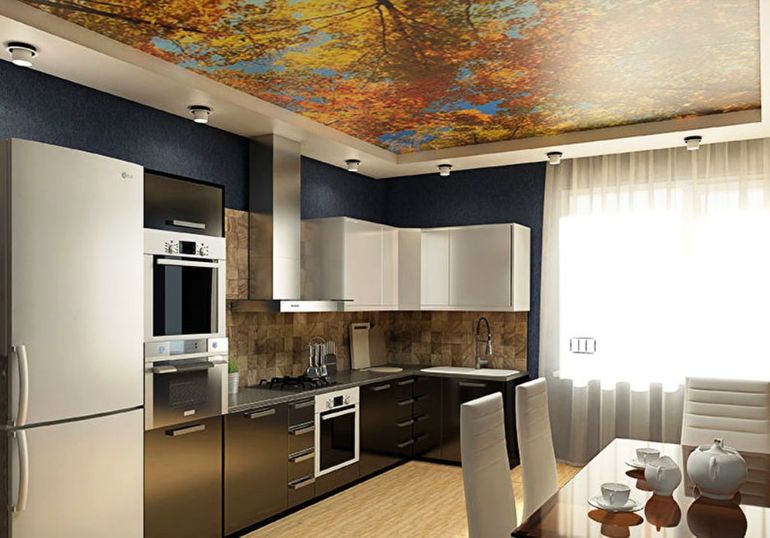
Another advantage of the material is that it can be used to make multi-level ceilings. However, this option cannot be called a budget one, because often the installation of drywall cannot be carried out independently without the involvement of qualified specialists.
The disadvantage is that repair work on installation requires significant time costs, especially when it comes to multi-level ceilings.
Tensile structures
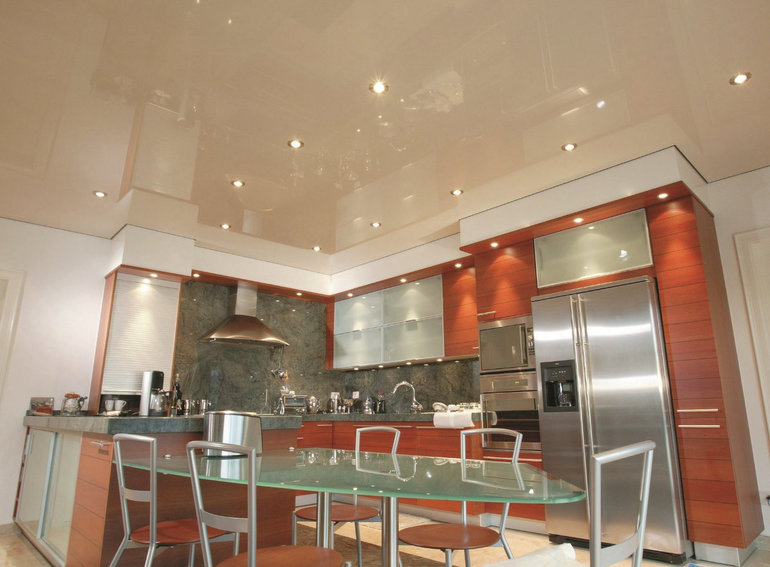
If the owners want to achieve a perfectly flat surface, you should give preference to stretch ceilings. They consist of film or fabric webs that are pulled onto a metal frame.
Doing it yourself will not work, only specialists should do the work. A big advantage compared to drywall is that the installation is carried out within a few hours. In addition, any image, including a photo, can be applied to the surface.
Tensile structures are not afraid of moisture. In addition, they are easy to care for. There are several types of products:
- Matte - allow you to simulate a painted ceiling.
- Satin - modest and at the same time presentable.
- Glossy - visually expand small rooms.
Wood application
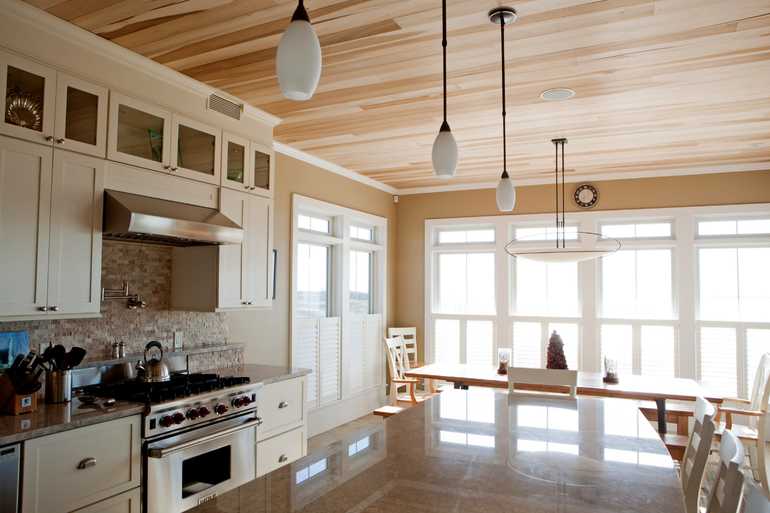
It should be noted that such a method of decoration is permissible to use far from all interiors. First of all, a kitchen with a wooden ceiling should not be small, especially if it is planned to use dark wood.
Secondly, the installation of such products requires an appropriate interior. Before sheathing the ceiling, it is imperative that all wooden parts should be treated with refractory agents and compounds that prevent decay. The use of moisture protective preparations (wax or paint) is also necessary. These measures will extend the life of the coating.
Today, there are several different design options (from budget to more expensive). Some of them:
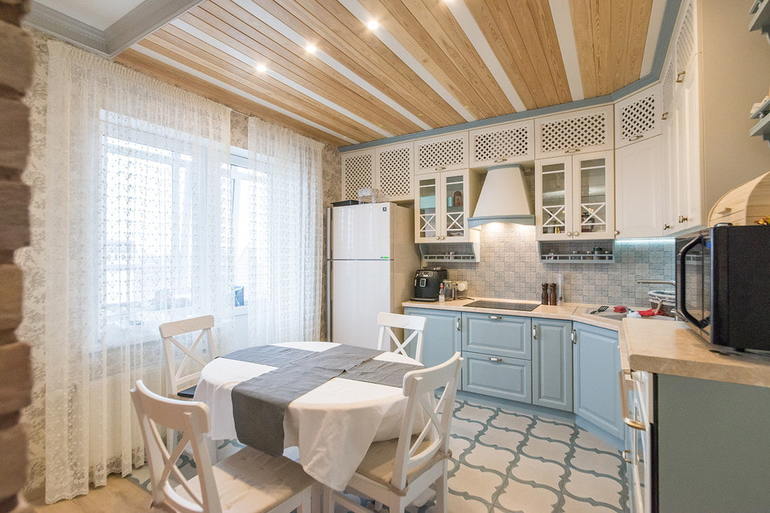
- Lining. With its help, you can cheaply trim the ceiling structure with wood. The material is presented in the form of long boards with a thorn-groove fastener. This makes it possible to easily assemble the structure and fix it on a previously prepared crate.
- Rack system - a lattice of bars that are fixed on a metal frame in a secret way. Now this option is quite in demand.
- Wooden panels can be made of solid wood, three-layer boards, MDF or plywood. The listed options differ in cost. Installation is carried out on a pre-prepared wooden crate.
- Laminate. Oddly enough, it is quite possible for them to draw up a ceiling, but only moisture-proof material needs to be used. Installation is done in a hemmed way, which allows you to save the height of the room.
Expert Advice
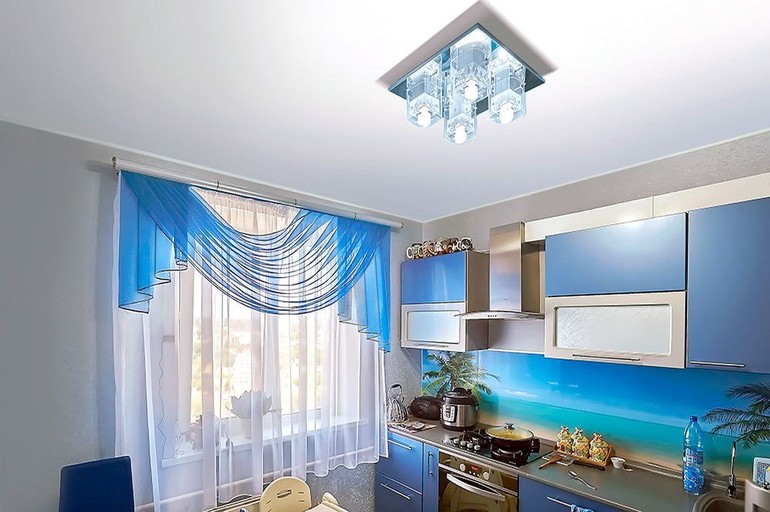
Experienced designers recommend choosing a ceiling that will be combined in color with the interior and furniture. If you plan to paint, it is better to give preference to light colors or white acrylic.To create a merging image of the ceiling structure and walls, you can use the same paintwork material - glossy or matte.
It is perfectly acceptable to install suspended ceilings equipped with spotlights in a modern kitchen. Practice shows that luminaires can be located in the transitions of a multi-level design.
For a private house, experts recommend installing refractory plasterboard coverings. It is preferable to use paint as a decor, because it does not deform, is resistant to humidity and temperature. In wooden buildings, rack ceilings are often installed, having the texture of natural wood.
Today, there are many different ways to decorate the ceiling in the kitchen. To choose the right option, you should study what materials there are, their features and advantages. It is necessary to build on the budget and taste preferences of the owners.
- How to choose a vacuum cleaner taking into account the characteristics of the house and coatings?
- What to look for when choosing a water delivery
- How to quickly create comfort at home - tips for housewives
- How to choose the perfect TV - useful tips
- What to look for when choosing blinds
- What should be running shoes?
- What useful things can you buy in a hardware store
- Iphone 11 pro max review
- Than iPhone is better than Android smartphones



